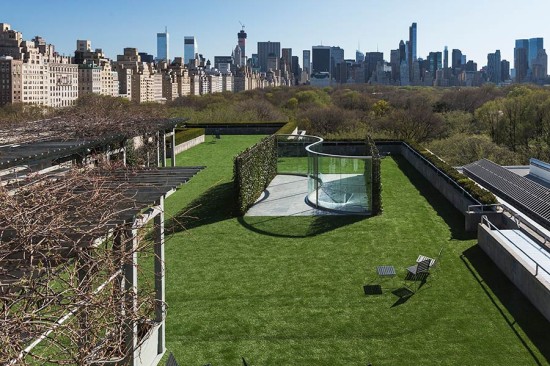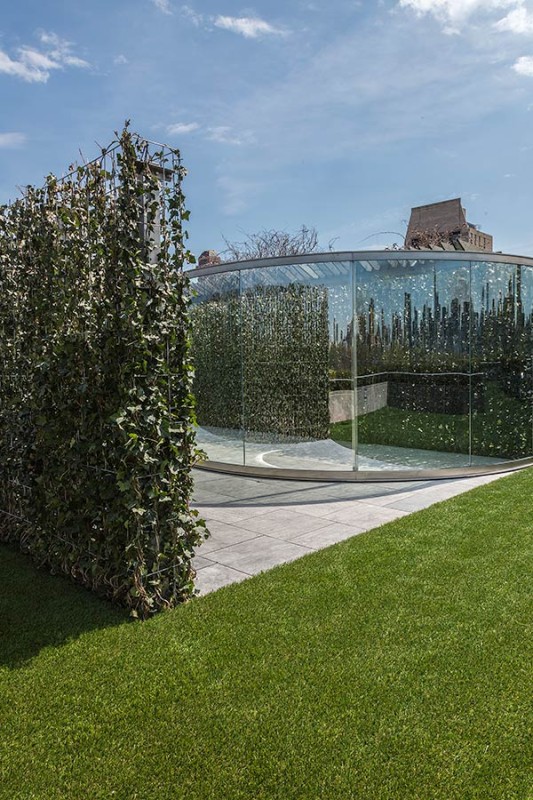
Hedge Two-Way Mirror Walkabout
Metropolitan Museum of Art
1000 5th Avenue, New York
Through November 2. 2014
One of the great gifts bestowed on New York in the summer is the Metropolitan Museum of Art’s roof garden. You are thrust into Olmsted’s Central Park from a promontory surrounded by the perimeter skyline on all sides. The trick with the rooftop art commissions is to play with the space, the views, and the interrelationships between the two. The goal is to make the viewer see them differently—you want to feel like the rooftop is your personal terrace in the sky while sharing it with others in a magnificent secret shared space.

Dan Graham’s Hedge Two-Way Mirror Walkabout plays with what he calls this “leftover space” of rooftop by framing the viewer’s “elliptical experience” with various man-made and natural elements: glass, steel, stone, hedgerows, chairs, and ForeverLawn (definitely not AstroTurf).
Stepping from the fake grass that covers the rooftop—green mixed with yellow and brown in different blade thicknesses—one climbs almost imperceptibly onto a slightly-raised platform of granite slabs that forms a square. These pavers support a sinuous bisecting slab of steel-trimmed, S-shaped, mirrored glass, a staple of modern skyscrapers, that is supported on the east and west sides by hedges, that, as Graham noted, demarcate property lines.
If you enter from the north side, you can gaze through the glass barrier to those on other side and to Central Park South beyond. When you approach from the south side, you are struck by the reflections of the skyline behind. It’s a concave/convex funhouse, where one is constantly catching glimpses oneself.
Graham has been working with “pavilions” for a long time, and Hedge Two-Way Mirror Walkabout feels like a more rural version of his much-missed Rooftop Urban Park Project (1991) atop the Dia Center for the Arts on West 22nd Street. You want to sit on the lawn and have a picnic. At the Met, Graham worked with Swiss landscape architect Günther Vogt, who also designed the stainless steel moveable chairs with recycled rubber coating manufactured by Burri.
On the museum’s second floor are related projects by Graham which attest to his long-standing interest in architecture and public space. A 20-minute video called Two-Way Mirror Cylinder inside Cube and a Video Salon (1992), commissioned by Dia, investigates atria, shopping arcades, and winter gardens, both historical and contemporary ranging from the Crystal Palace, Galleria Vittorio Emanuele, the Ford Foundation, Citicorp Park Avenue Atrium, Charles deGaul airport, Parc de La Villette, World Financial Center’s Winter Garden, and the IBM Building. Graham narrates, as he does in Two-Way Mirror Hedge Labyrinth (1991), a short video centered on a pavilion installed at a private home in La Jolla, CA, where he muses on the city—how landscape architecture redefines it, how the labyrinth is a metaphor for it, and how two-way mirrored glass’ transparency and reflectivity mimics it. Graham’s concerns with movement and time, human interplay and asymmetrical procession, all take place on a mirrored stage.











